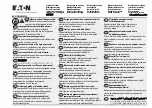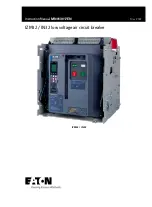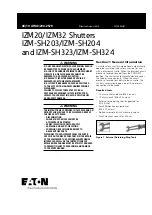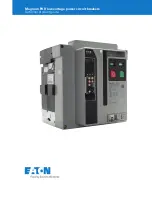
www.weg.net
WEG Molded Case Circuit Breakers - User’s Manual
7
4.1. INSPECTION
Circuit breakers in service should be inspected periodically. The inspection should
include the following checks 1 thru 7.
WARNING
Before inspecting the circuit breaker in an electrical system, make sure
the circuit breaker is switched to the off position and there is no voltage
present where work is to be performed. Special attention should be paid
to reverse feed applications to ensure no voltage is present. The voltages
in energized equipment can cause injury or death.
CAUTION
Make sure that cleaning agents or solvents used to clean the circuit
breaker are suitable for the job. Some commercial cleaning agents will
damage the name plates or molded parts.
1. Remove dust, dirt, soot, grease, or moisture from the surface of the circuit
breaker using a lint-free dry cloth, brush, or vacuum cleaner. Do not blow debris
into circuit breaker. If contamination is found, look for the source and eliminate
the problem.
2. Switch circuit breaker to ON and OFF several times to be sure that the mechanical
linkages are free and do not bind. If mechanical linkages are not free, replace
circuit breaker.
3. Press the PUSH-TO-TRIP button to mechanically trip the circuit breaker. Trip,
reset, and switch circuit breaker ON several times. If mechanism does not reset
each time the circuit breaker is tripped, replace the circuit.
4. Check base, cover, and operating handle for cracks, chipping, and discoloration.
Circuit breakers should be replaced if cracks or severe discoloration is found.
5. Check terminals and connectors for looseness or signs of over-heating.
Overheating will show as discoloration, melting, or blister- ing of conductor
insulation, or as pitting or melting of conductor sur- faces due to arcing. If
there is no evidence of overheating or loose- ness, do not disturb or tighten
the connections. If there is evidence of overheating, terminations should be
cleaned or replaced. Before re-energizing the circuit breaker, all terminations
and cable should be refurbished to the condition when originally installed.
6. Check circuit breaker mounting hardware. Tighten if necessary.
7. Check area where circuit breaker is installed for any safety hazards, including
personal safety and fire hazards. Exposure to certain types of chemicals can
cause deterioration of electrical connections.
4.2. FIELD TESTING
Any field testing should be done in accordance with applicable NEMA Standards.






























